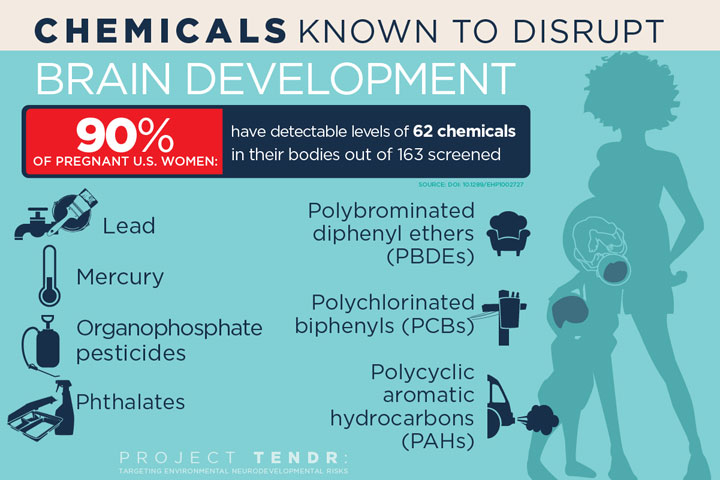
Credit: Graphic by Julie McMahon
CHAMPAIGN, Ill. — In a new report, dozens of scientists, health practitioners and children's health advocates are calling for renewed attention to the growing evidence that many common and widely available chemicals endanger neurodevelopment in fetuses and children of all ages.
The chemicals that are of most concern include lead and mercury; organophosphate pesticides used in agriculture and home gardens; phthalates, found in pharmaceuticals, plastics and personal care products; flame retardants known as polybrominated diphenyl ethers; and air pollutants produced by the combustion of wood and fossil fuels, said University of Illinois comparative biosciences professor Susan Schantz, one of dozens of individual signatories to the consensus statement.
Polychlorinated biphenyls, once used as coolants and lubricants in transformers and other electrical equipment, also are of concern. PCBs were banned in the U.S. in 1977, but can persist in the environment for decades, she said.
The new report, "Project TENDR: Targeting Environmental NeuroDevelopment Risks," appears in the journal Environmental Health Perspectives.
"These chemicals are pervasive, not only in air and water, but in everyday consumer products that we use on our bodies and in our homes," Schantz said. "Reducing exposures to toxic chemicals can be done, and is urgently needed to protect today's and tomorrow's children."
Schantz is a faculty member in the College of Veterinary Medicine and in the Beckman Institute for Advanced Science and Technology at the U. of I. See a video about her work and the Project TENDR initiative.
"The human brain develops over a very long period of time, starting in gestation and continuing during childhood and even into early adulthood," Schantz said. "But the biggest amount of growth occurs during prenatal development. The neurons are forming and migrating and maturing and differentiating. And if you disrupt this process, you're likely to have permanent effects."
Some of the chemicals of concern, such as phthalates and PBDEs, are known to interfere with normal hormone activity. For example, most pregnant women in the U.S. will test positive for exposure to phthalates and PBDEs, both of which disrupt thyroid hormone function.
"Thyroid hormone is involved in almost every aspect of brain development, from formation of the neurons to cell division, to the proper migration of cells and myelination of the axons after the cells are differentiated," said Schantz. "It regulates many of the genes involved in nervous system development."
Schantz and her colleagues at Illinois are studying infants and their mothers to determine whether prenatal exposure to phthalates and other endocrine disruptors leads to changes in the brain or behavior. This research, along with parallel studies in older children and animals, is a primary focus of the Children's Environmental Health Research Center at Illinois, which Schantz directs.
Phthalates also interfere with steroid hormone activity. Studies link exposure to certain phthalates with attention deficits, lower IQ and conduct disorders in children. "Phthalates are everywhere; they're in all kinds of different products. We're exposed to them every day," Schantz said.
The report criticizes current regulatory lapses that allow chemicals to be introduced into people's lives with little or no review of their effects on fetal and child health.
"For most chemicals, we have no idea what they're doing to children's neurodevelopment," Schantz said. "They just haven't been studied.
"And if it looks like something is a risk, we feel policymakers should be willing to make a decision that this or that chemical could be a bad actor and we need to stop its production or limit its use," she said. "We shouldn't have to wait 10 or 15 years — allowing countless children to be exposed to it in the meantime — until we're positive it's a bad actor."
###
The National Institute of Environmental Health Sciences at the National Institutes of Health and the U.S. Environmental Protection Agency fund the Children's Environmental Health Research Center at the University of Illinois.
Editor's notes:
To reach Susan Schantz, call 217-333-6230; email [email protected]
The paper "Project TENDR: Targeting Environmental NeuroDevelopment Risks" is available from the U. of I. News Bureau.
Media Contact
Diana Yates
[email protected]
217-333-5802
@NewsAtIllinois
http://www.illinois.edu





